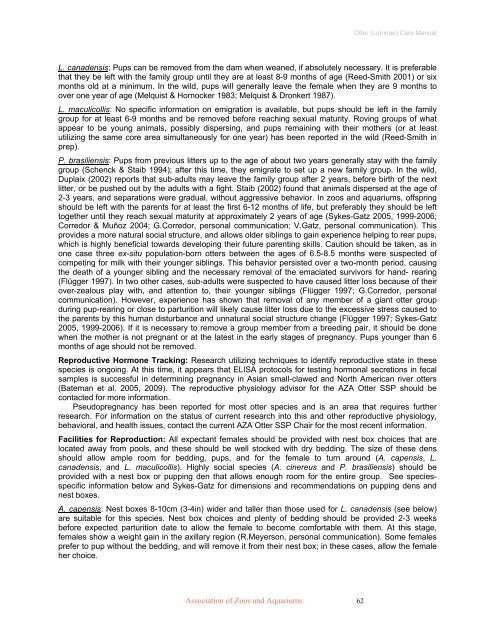Otter (Lutrinae) Care Manual - Association of Zoos and Aquariums
Otter (Lutrinae) Care Manual - Association of Zoos and Aquariums
Otter (Lutrinae) Care Manual - Association of Zoos and Aquariums
You also want an ePaper? Increase the reach of your titles
YUMPU automatically turns print PDFs into web optimized ePapers that Google loves.
<strong>Association</strong> <strong>of</strong> <strong>Zoos</strong> <strong>and</strong> <strong>Aquariums</strong> 62<br />
<strong>Otter</strong> (<strong>Lutrinae</strong>) <strong>Care</strong> <strong>Manual</strong><br />
L. canadensis: Pups can be removed from the dam when weaned, if absolutely necessary. It is preferable<br />
that they be left with the family group until they are at least 8-9 months <strong>of</strong> age (Reed-Smith 2001) or six<br />
months old at a minimum. In the wild, pups will generally leave the female when they are 9 months to<br />
over one year <strong>of</strong> age (Melquist & Hornocker 1983; Melquist & Dronkert 1987).<br />
L. maculicollis: No specific information on emigration is available, but pups should be left in the family<br />
group for at least 6-9 months <strong>and</strong> be removed before reaching sexual maturity. Roving groups <strong>of</strong> what<br />
appear to be young animals, possibly dispersing, <strong>and</strong> pups remaining with their mothers (or at least<br />
utilizing the same core area simultaneously for one year) has been reported in the wild (Reed-Smith in<br />
prep).<br />
P. brasiliensis: Pups from previous litters up to the age <strong>of</strong> about two years generally stay with the family<br />
group (Schenck & Staib 1994); after this time, they emigrate to set up a new family group. In the wild,<br />
Duplaix (2002) reports that sub-adults may leave the family group after 2 years, before birth <strong>of</strong> the next<br />
litter, or be pushed out by the adults with a fight. Staib (2002) found that animals dispersed at the age <strong>of</strong><br />
2-3 years, <strong>and</strong> separations were gradual, without aggressive behavior. In zoos <strong>and</strong> aquariums, <strong>of</strong>fspring<br />
should be left with the parents for at least the first 6-12 months <strong>of</strong> life, but preferably they should be left<br />
together until they reach sexual maturity at approximately 2 years <strong>of</strong> age (Sykes-Gatz 2005, 1999-2006;<br />
Corredor & Muñoz 2004; G.Corredor, personal communication; V.Gatz, personal communication). This<br />
provides a more natural social structure, <strong>and</strong> allows older siblings to gain experience helping to rear pups,<br />
which is highly beneficial towards developing their future parenting skills. Caution should be taken, as in<br />
one case three ex-situ population-born otters between the ages <strong>of</strong> 6.5-8.5 months were suspected <strong>of</strong><br />
competing for milk with their younger siblings. This behavior persisted over a two-month period, causing<br />
the death <strong>of</strong> a younger sibling <strong>and</strong> the necessary removal <strong>of</strong> the emaciated survivors for h<strong>and</strong>- rearing<br />
(Flügger 1997). In two other cases, sub-adults were suspected to have caused litter loss because <strong>of</strong> their<br />
over-zealous play with, <strong>and</strong> attention to, their younger siblings (Flügger 1997; G.Corredor, personal<br />
communication). However, experience has shown that removal <strong>of</strong> any member <strong>of</strong> a giant otter group<br />
during pup-rearing or close to parturition will likely cause litter loss due to the excessive stress caused to<br />
the parents by this human disturbance <strong>and</strong> unnatural social structure change (Flügger 1997; Sykes-Gatz<br />
2005, 1999-2006). If it is necessary to remove a group member from a breeding pair, it should be done<br />
when the mother is not pregnant or at the latest in the early stages <strong>of</strong> pregnancy. Pups younger than 6<br />
months <strong>of</strong> age should not be removed.<br />
Reproductive Hormone Tracking: Research utilizing techniques to identify reproductive state in these<br />
species is ongoing. At this time, it appears that ELISA protocols for testing hormonal secretions in fecal<br />
samples is successful in determining pregnancy in Asian small-clawed <strong>and</strong> North American river otters<br />
(Bateman et al. 2005, 2009). The reproductive physiology advisor for the AZA <strong>Otter</strong> SSP should be<br />
contacted for more information.<br />
Pseudopregnancy has been reported for most otter species <strong>and</strong> is an area that requires further<br />
research. For information on the status <strong>of</strong> current research into this <strong>and</strong> other reproductive physiology,<br />
behavioral, <strong>and</strong> health issues, contact the current AZA <strong>Otter</strong> SSP Chair for the most recent information.<br />
Facilities for Reproduction: All expectant females should be provided with nest box choices that are<br />
located away from pools, <strong>and</strong> these should be well stocked with dry bedding. The size <strong>of</strong> these dens<br />
should allow ample room for bedding, pups, <strong>and</strong> for the female to turn around (A. capensis, L.<br />
canadensis, <strong>and</strong> L. maculicollis). Highly social species (A. cinereus <strong>and</strong> P. brasiliensis) should be<br />
provided with a nest box or pupping den that allows enough room for the entire group. See speciesspecific<br />
information below <strong>and</strong> Sykes-Gatz for dimensions <strong>and</strong> recommendations on pupping dens <strong>and</strong><br />
nest boxes.<br />
A. capensis: Nest boxes 8-10cm (3-4in) wider <strong>and</strong> taller than those used for L. canadensis (see below)<br />
are suitable for this species. Nest box choices <strong>and</strong> plenty <strong>of</strong> bedding should be provided 2-3 weeks<br />
before expected parturition date to allow the female to become comfortable with them. At this stage,<br />
females show a weight gain in the axillary region (R.Meyerson, personal communication). Some females<br />
prefer to pup without the bedding, <strong>and</strong> will remove it from their nest box; in these cases, allow the female<br />
her choice.









